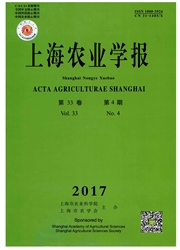

 中文摘要:
中文摘要:
为了探究猪流性腹泻病毒(PEDV)感染对小型猪组织脏器的影响,将PEDV流行株SHpd/2012经口服感染5日龄小型猪,待其出现明显临床症状且濒临死亡时剖杀,并采集小肠、肠系膜淋巴结、脾、肾、肝等组织脏器制作病理切片进行显微观察,同时利用抗PEDV特异性单抗对各组织进行免疫组织化学观察。结果显示:小型猪在攻毒后24 h即出现猪流行性腹泻的典型临床症状,猪只表现出明显的水样腹泻,同时伴随有呕吐、脱水等症状,甚至出现身体衰竭。解剖观察攻毒组小型猪内脏,可见肠腔内充满黄白色内容物和气体,肠壁变薄,呈半透明状;肠系膜淋巴结显著肿大,其他组织脏器未发现肉眼可见的病理变化。组织病理学观察显示攻毒组小型猪小肠组织病变最为严重,主要表现为小肠绒毛脱落、崩解、萎缩。此外,肠系膜淋巴结出血、有大量炎性细胞浸润;脾脏有大量炎性细胞浸润,脾小梁溶解消失,红髓白髓界限不清;肾脏肾小球变性坏死,肾单位结构崩解,模糊不清。免疫组化分析结果显示,攻毒组试验猪的小肠组织中可检测到大量病毒感染的细胞,而在肺脏、肝脏、肾脏、脾脏等组织中均未检测到PEDV分布。这一结果表明SHpd/2012株与经典毒株相比病变范围有所扩大,为深入研究PEDV致病机制积累了科学数据。
 英文摘要:
英文摘要:
In order to investigate the effects of porcine epidemic tissues and organs, 5-day-old specific-pathogen-free miniature pigs strain SHpd/2012 and euthanized when clear clinical signs appeared diarrhea virus (PEDV) on miniature pigs' were infected orally with a variant PEDV and they were on the verge of death, and then their small intestines, mesenteric lymph nodes, spleens, kidneys and livers were collected and prepared for microscopic examination and immunohistochemistry (IHC)test. The results showed that typical clinical signs of porcine epidemic diarrhea appeared at 24 hours post infection (hpi) , including obvious watery diarrhea, vomiting and even exhaustion. The euthanized pigs' enteric cavities were filled with yellowish fluid contents and gas, their intestinal walls became thin and semitransparent and their mesenteric lymph nodes were swollen, but other tissues and organs had no pathological changes visible to the naked eye. The histopathological examination found that the intestine tissue had the heaviest lesion, mainly with the intestinal villi shedding, disintegrating and atrophying. Besides,the mesenteric lymph nodes bled and were infiltrated by a large number of inflammatory eel_Is; the spleens were characterized by the infiltration of inflammatory cells, disappearance of trabecula, and blurry boundary between the red and white pulps; the kidneys showed necrotic glomeruli and renal structure disintegration and uncleanness. The IHC test showed that a large number of PEDV particles could be detected in the small intestinal tissues of the challenge group but no viral particles could be detected in the lung, liver, kidney, spleen and other organs. The above results indicated that the pathogenicity of the strain SHpd/2012 was somewhat different from the classical strains', accumulating more data for further research on PEDV pathogenesis.
 同期刊论文项目
同期刊论文项目
 同项目期刊论文
同项目期刊论文
 期刊信息
期刊信息
